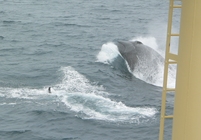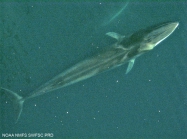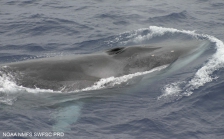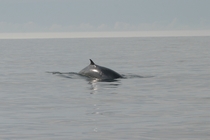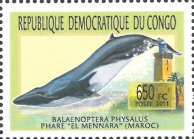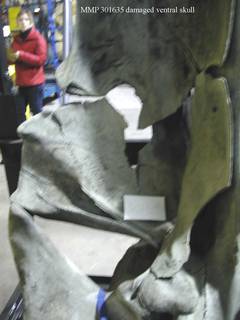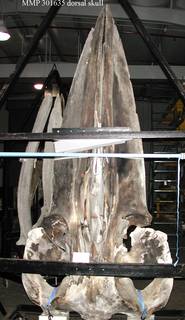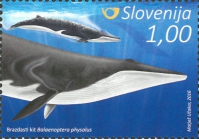
| Intro | | About | | Wiki | | Search traits | | Data explorer | | Literature | | Definitions | | Sources | | Webservices | | Statistics | | Feedback | | Editors | | Log in |
WoRMS taxon detailsBalaenoptera physalus (Linnaeus, 1758)
137091 (urn:lsid:marinespecies.org:taxname:137091)
accepted
Species
Balaena antipodarum Tomilin, 1957 · unaccepted (synonym)
Balaena antiquorum Fischer, 1829 · unaccepted (synonym)
Balaena boops Linnaeus, 1758 · unaccepted (synonym)
Balaena maximus borealis Knox, 1838 · unaccepted (synonym)
Balaena mysticetus major Kerr, 1792 · unaccepted (synonym)
Balaena physalis Kerr, 1792 · unaccepted (synonym)
Balaena physalus Linnaeus, 1758 · unaccepted (basionym)
Balaena quoyi Fischer, 1829 · unaccepted (synonym)
Balaena rostrata australis Desmoulins, 1822 · unaccepted (synonym)
Balaena sulcata Neill, 1811 · unaccepted (synonym)
Balaenoptera antarctica Gray, 1846 · unaccepted (synonym)
Balaenoptera aragous Farines & Carcasonne, 1829 · unaccepted (synonym)
Balaenoptera australis Gray, 1846 · unaccepted (synonym)
Balaenoptera blythii Anderson, 1879 · unaccepted (synonym)
Balaenoptera brasiliensis Gray, 1846 · unaccepted (synonym)
Balaenoptera gibbar Lacépède, 1804 · unaccepted (synonym)
Balaenoptera mediterraneensis Lesson, 1828 · unaccepted (synonym)
Balaenoptera mediterranensis Cabrera, 1961 · unaccepted (misspelling)
Balaenoptera musculus Van Beneden & Gervais, 1880 · unaccepted (synonym)
Balaenoptera patachonica Lahille, 1905 · unaccepted (synonym)
Balaenoptera patachonicus Burmeister, 1865 · unaccepted (synonym)
Balaenoptera patagonica Dabbene, 1902 · unaccepted (synonym)
Balaenoptera quoyii Lonnberg, 1906 · unaccepted (synonym)
Balaenoptera rorqual Lacépède, 1804 · unaccepted (synonym)
Balaenoptera sulcata · alternative representation
Balaenoptera sulcata arctica Schlegel, 1841 · unaccepted (synonym)
Balaenoptera swinhoii Gray, 1866 · unaccepted (synonym)
Balaenoptera tenuirostris Sweeting, 1840 · unaccepted (synonym)
Balaenoptera velifera Cope, 1869 · unaccepted (synonym)
Balaenoptera velifera copei Elliot, 1901 · unaccepted (synonym)
Balaenopteris guibusdam Tomilin, 1957 · unaccepted (synonym)
Benedenia knoxii Gray, 1864 · unaccepted (synonym)
Dubertus rhodinsulensis Tomilin, 1957 · unaccepted (synonym)
Physalis vulgaris Fleming, 1828 · unaccepted (synonym)
Physalus antarcticus Gray, 1850 · unaccepted (synonym)
Physalus australis Gray, 1850 · unaccepted (synonym)
Physalus brasiliensis Gray, 1850 · unaccepted (synonym)
Physalus dugundii Heddle, 1856 · unaccepted (synonym)
Physalus fasciatus Gray, 1850 · unaccepted (synonym)
Physalus patachonicus Burmeister, 1866 · unaccepted (synonym)
Physalus verus Billberg, 1828 · unaccepted (synonym)
Pterobalaena communis Van Beneden, 1857 · unaccepted (synonym)
Pterobalaena gigantea · alternative representation
Pterobalaena gigantea michrochira Barkos, 1862 · unaccepted (synonym)
Rorqualus musculus F. Cuvier, 1836 · unaccepted (synonym)
Sibbaldius tectirostris Cope, 1869 · unaccepted (synonym)
Sibbaldius tuberosus Cope, 1869 · unaccepted (synonym)
Swinhoia chinensis Gray, 1868 · unaccepted (synonym)
marine,
(of Balaena physalus Linnaeus, 1758) Linnaeus, C. (1758). Systema Naturae per regna tria naturae, secundum classes, ordines, genera, species, cum characteribus, differentiis, synonymis, locis. [The system of nature through the three kingdoms of nature, according to classes, orders, genera, species, with characters, differences, synonyms, places.]. <em>Impensis Direct. Laurentii Salvii. Holmiae [Stockholm].</em> 1(10) [iii], 824 p., available online at https://biodiversitylibrary.org/page/726886
page(s): 75 [details] Available for editors
Note "Oceano Europaeo," specifically the...
From editor or global species database
Type locality "Oceano Europaeo," specifically the Spitzbergen Sea [details]
Distribution in all oceans
Distribution in all oceans [details] Distribution Antarctica/Southern Ocean; East Pacific; Eastern Atlantic Ocean; Indo-West Pacific; Western Atlantic Ocean
Distribution Antarctica/Southern Ocean; East Pacific; Eastern Atlantic Ocean; Indo-West Pacific; Western Atlantic Ocean [details]
Fordyce, E.; Perrin, W.F. (2025). World Cetacea Database. Balaenoptera physalus (Linnaeus, 1758). Accessed through: World Register of Marine Species at: https://www.marinespecies.org/aphia.php?p=taxdetails&id=137091 on 2025-07-18
Date action by
Nomenclatureoriginal description
(of Balaena boops Linnaeus, 1758) Linnaeus, C. (1758). Systema Naturae per regna tria naturae, secundum classes, ordines, genera, species, cum characteribus, differentiis, synonymis, locis. [The system of nature through the three kingdoms of nature, according to classes, orders, genera, species, with characters, differences, synonyms, places.]. <em>Impensis Direct. Laurentii Salvii. Holmiae [Stockholm].</em> 1(10) [iii], 824 p., available online at https://biodiversitylibrary.org/page/726886 [details] Available for editors original description (of Balaena physalus Linnaeus, 1758) Linnaeus, C. (1758). Systema Naturae per regna tria naturae, secundum classes, ordines, genera, species, cum characteribus, differentiis, synonymis, locis. [The system of nature through the three kingdoms of nature, according to classes, orders, genera, species, with characters, differences, synonyms, places.]. <em>Impensis Direct. Laurentii Salvii. Holmiae [Stockholm].</em> 1(10) [iii], 824 p., available online at https://biodiversitylibrary.org/page/726886 page(s): 75 [details] Available for editors basis of record van der Land, J. (2001). Tetrapoda, <B><I>in</I></B>: Costello, M.J. <i>et al.</i> (Ed.) (2001). <i>European register of marine species: a check-list of the marine species in Europe and a bibliography of guides to their identification. Collection Patrimoines Naturels,</i> 50: pp. 375-376 (look up in IMIS) [details] Ecologyecology source
Looby, A.; Erbe, C.; Bravo, S.; Cox, K.; Davies, H. L.; Di Iorio, L.; Jézéquel, Y.; Juanes, F.; Martin, C. W.; Mooney, T. A.; Radford, C.; Reynolds, L. K.; Rice, A. N.; Riera, A.; Rountree, R.; Spriel, B.; Stanley, J.; Vela, S.; Parsons, M. J. G. (2023). Global inventory of species categorized by known underwater sonifery. <em>Scientific Data.</em> 10(1). (look up in IMIS), available online at https://doi.org/10.1038/s41597-023-02745-4 [details] Othercontext source (PeRMS)
Reyes, J. (2009). Ballenas, delfines y otros cetáceos del Perú. Una fuente de información. <em>Lima- Perú. Squema-Ediciones.</em> 160 pp. [details]
additional source Carwardine, M., E. Hoyt, R. E. Fordyce and P. Gill. 1998. Whales, dolphins and porpoises. Time-Life Books. Nature Company Guides, USA. 288 p. [details] additional source Thomas, M. L. H. (1983). Marine and coastal systems of the Quoddy Region, New Brunswick. <em>Canadian Special Publication of Fisheries and Aquatic Sciences.</em> 64:1-306. [details] Available for editors additional source Muller, Y. (2004). Faune et flore du littoral du Nord, du Pas-de-Calais et de la Belgique: inventaire. [Coastal fauna and flora of the Nord, Pas-de-Calais and Belgium: inventory]. <em>Commission Régionale de Biologie Région Nord Pas-de-Calais: France.</em> 307 pp., available online at http://www.vliz.be/imisdocs/publications/145561.pdf [details] additional source Mead, J. G.; Brownell, R. L. Jr. (2005). Cetacea. <em>In Wilson, D.E. & D.M. Reeder (eds). Mammal Species of the World. A Taxonomic and Geographic Reference (3rd ed), Johns Hopkins University Press, 2,142 pp.</em> 723--743., available online at http://www.bucknell.edu/msw3/ [details] additional source Rice, D. W. (1998). Marine mammals of the world. Systematics and distribution. <em>Society for Marine Mammalogy Special Publication.</em> 4., available online at http://www.marinemammalscience.org/wp-content/uploads/2014/09/MarineMammalsOfTheWorld.pdf [details] additional source Hershkovitz, P. (1966). Catalog of Living Whales. <em>Bulletin of the United States National Museum.</em> (246): 1-259., available online at https://doi.org/10.5479/si.03629236.246 [details] additional source Jefferson, T. A., M. A. Webber and R. L. Pitman. (2008). Marine mammals of the world. Academic Press, Amsterdam. [details] additional source IUCN Red List of Threatened Species, available online at http://www.iucnredlist.org [details] additional source Perrin, W.F.; Würsig, B.; Thewissen, J.G.M. (2009). Encyclopedia of marine mammals. Second edition. Academic Press: London. ISBN 978-0-12-373553-9. xxix, 1316 pp. (look up in IMIS) [details] additional source King, C.M.; Roberts, C.D.; Bell, B.D.; Fordyce, R.E.; Nicoll, R.S.; Worthy, T.H.; Paulin, C.D.; Hitchmough, R.A.; Keyes, I.W.; Baker, A.N.; Stewart, A.L.; Hiller, N.; McDowall, R.M.; Holdaway, R.N.; McPhee, R.P.; Schwarzhans, W.W.; Tennyson, A.J.D.; Rust, S.; Macadie, I. (2009). Phylum Chordata: lancelets, fishes, amphibians, reptiles, birds, mammals. <em>in: Gordon, D.P. (Ed.) (2009). New Zealand inventory of biodiversity: 1. Kingdom Animalia: Radiata, Lophotrochozoa, Deuterostomia.</em> pp. 431-554. [details] additional source Schmidly, D. J. and B. Würsig. 2009. Mammals (Vertebrata: Mammalia) of the Gulf of Mexico, Pp. 1343–1352 in Felder, D.L. and D.K. Camp (eds.), Gulf of Mexico–Origins, Waters, and Biota. Biodiversity. Texas A&M Press, College Station, Texas. [details] additional source Liu, J.Y. [Ruiyu] (ed.). (2008). Checklist of marine biota of China seas. <em>China Science Press.</em> 1267 pp. (look up in IMIS) [details] Available for editors additional source Integrated Taxonomic Information System (ITIS). , available online at http://www.itis.gov [details]  Present Present  Present in aphia/obis/gbif/idigbio Present in aphia/obis/gbif/idigbio  Inaccurate Inaccurate  Introduced: alien Introduced: alien  Containing type locality Containing type locality
From editor or global species database
Holotype None; based primarily on the "finfish" of Martens (1675) [details]IUCN Red List Category Endangered (EN) [details] Morphology Distinguishing characteristics: white lower jaw on right, gray on left. Blow readily visible-10 m(33') tall, straight column. Curved dorsal fin closer to tail. light grey with white belly, occasional blotches of orange/yellow, blaze or chevron extending from eye across back. Fin and blue whales have the deepest, loudest voices in the ocean, letting them communicate over great distances. Second largest living animal after the blue whale. [details] Predators Killer whale (Orcinus orca) [details] Reproduction Calving: December to April in Northern Hemisphere, austral winter in Southern Hemisphere, in unknown localities; Weaning: 1 year [details] Type locality "Oceano Europaeo," specifically the Spitzbergen Sea [details] Unreviewed
Diet schooling fish, euphasiids and other invetebrates, copepods (when young), squid [details]Dimensions Length: male 58-82' (17.7-25 m), female 60-88 1/2' (18.3-27 m), at birth 19 1/2' + (5.9 m+) [details] Distribution in all oceans [details] Distribution Antarctica/Southern Ocean; East Pacific; Eastern Atlantic Ocean; Indo-West Pacific; Western Atlantic Ocean [details] Habitat mostly offshore but also near the coast [details] Importance In the North-West Atlantic region, it is the dominant large cetacean species in all seasons, with the largest standing stock, the largest food requirements, and therefore the largest impact on the ecosystem of any cetacean species. [details]
Marine Life Information Network - UK
To Barcode of Life (162 barcodes) To Barcode of Life (5 barcodes) (from synonym Balaenoptera musculus Van Beneden & Gervais, 1880) To Biodiversity Heritage Library (1 publication) (from synonym Physalus verus Billberg, 1828) To Biodiversity Heritage Library (1 publication) (from synonym Pterobalaena gigantea) To Biodiversity Heritage Library (10 publications) (from synonym Balaenopteris guibusdam Tomilin, 1957) To Biodiversity Heritage Library (10 publications) (from synonym Physalus brasiliensis Gray, 1850) To Biodiversity Heritage Library (10 publications) (from synonym Balaena sulcata Neill, 1811) To Biodiversity Heritage Library (13 publications) (from synonym Physalus fasciatus Gray, 1850) To Biodiversity Heritage Library (13 publications) (from synonym Balaenoptera tenuirostris Sweeting, 1840) To Biodiversity Heritage Library (16 publications) (from synonym Physalus patachonicus Burmeister, 1866) To Biodiversity Heritage Library (16 publications) (from synonym Physalis vulgaris Fleming, 1828) To Biodiversity Heritage Library (17 publications) (from synonym Balaenoptera antarctica Gray, 1846) To Biodiversity Heritage Library (19 publications) (from synonym Balaenoptera rorqual Lacépède, 1804) To Biodiversity Heritage Library (2 publications) (from synonym Balaenoptera patachonicus Burmeister, 1865) To Biodiversity Heritage Library (2 publications) (from synonym Balaenoptera patagonica Dabbene, 1902) To Biodiversity Heritage Library (2 publications) (from synonym Balaena maximus borealis Knox, 1838) To Biodiversity Heritage Library (20 publications) (from synonym Rorqualus musculus F. Cuvier, 1836) To Biodiversity Heritage Library (21 publications) (from synonym Benedenia knoxii Gray, 1864) To Biodiversity Heritage Library (228 publications) To Biodiversity Heritage Library (23 publications) (from synonym Pterobalaena communis Van Beneden, 1857) To Biodiversity Heritage Library (24 publications) (from synonym Physalus australis Gray, 1850) To Biodiversity Heritage Library (27 publications) (from synonym Balaenoptera australis Gray, 1846) To Biodiversity Heritage Library (29 publications) (from synonym Physalus antarcticus Gray, 1850) To Biodiversity Heritage Library (3 publications) (from synonym Balaenoptera velifera copei Elliot, 1901) To Biodiversity Heritage Library (3 publications) (from synonym Balaenoptera quoyii Lonnberg, 1906) To Biodiversity Heritage Library (32 publications) (from synonym Balaenoptera gibbar Lacépède, 1804) To Biodiversity Heritage Library (32 publications) (from synonym Sibbaldius tuberosus Cope, 1869) To Biodiversity Heritage Library (34 publications) (from synonym Balaenoptera patachonica Lahille, 1905) To Biodiversity Heritage Library (350 publications) (from synonym Balaenoptera musculus Van Beneden & Gervais, 1880) To Biodiversity Heritage Library (39 publications) (from synonym Balaena physalis Kerr, 1792) To Biodiversity Heritage Library (4 publications) (from synonym Balaenoptera brasiliensis Gray, 1846) To Biodiversity Heritage Library (4 publications) (from synonym Balaenoptera mediterraneensis Lesson, 1828) To Biodiversity Heritage Library (43 publications) (from synonym Balaenoptera velifera Cope, 1869) To Biodiversity Heritage Library (47 publications) (from synonym Balaena antipodarum Tomilin, 1957) To Biodiversity Heritage Library (47 publications) (from synonym Balaena physalus Linnaeus, 1758) To Biodiversity Heritage Library (5 publications) (from synonym Balaenoptera swinhoii Gray, 1866) To Biodiversity Heritage Library (5 publications) (from synonym Balaenoptera sulcata) To Biodiversity Heritage Library (50 publications) (from synonym Sibbaldius tectirostris Cope, 1869) To Biodiversity Heritage Library (6 publications) (from synonym Balaenoptera blythii Anderson, 1879) To Biodiversity Heritage Library (7 publications) (from synonym Balaena rostrata australis Desmoulins, 1822) To Biodiversity Heritage Library (7 publications) (from synonym Dubertus rhodinsulensis Tomilin, 1957) To Biodiversity Heritage Library (71 publications) (from synonym Balaena boops Linnaeus, 1758) To Biodiversity Heritage Library (9 publications) (from synonym Balaena antiquorum Fischer, 1829) To Biodiversity Heritage Library (9 publications) (from synonym Swinhoia chinensis Gray, 1868) To Biological Information System for Marine Life (BISMaL) To European Nucleotide Archive, ENA (Balaenoptera musculus) (from synonym Balaenoptera musculus Van Beneden & Gervais, 1880) To European Nucleotide Archive, ENA (Balaenoptera physalus) To GenBank (76503 nucleotides; 21881 proteins) To GenBank (76503 nucleotides; 21881 proteins) (from synonym Balaena physalus Linnaeus, 1758) To Global Biotic Interactions (GloBI) To IUCN Red List (Endangered) (from synonym Balaenoptera musculus Van Beneden & Gervais, 1880) To IUCN Red List (Vulnerable) To NMNH Extant Collection (MMP USNM 301635 Balaenoptera physalus Damaged Ventral Skull) To NMNH Extant Collection (MMP USNM 301635 Balaenoptera physalus Dorsal Skull) To PESI To PESI (from synonym Balaenoptera musculus Van Beneden & Gervais, 1880) To ITIS |
